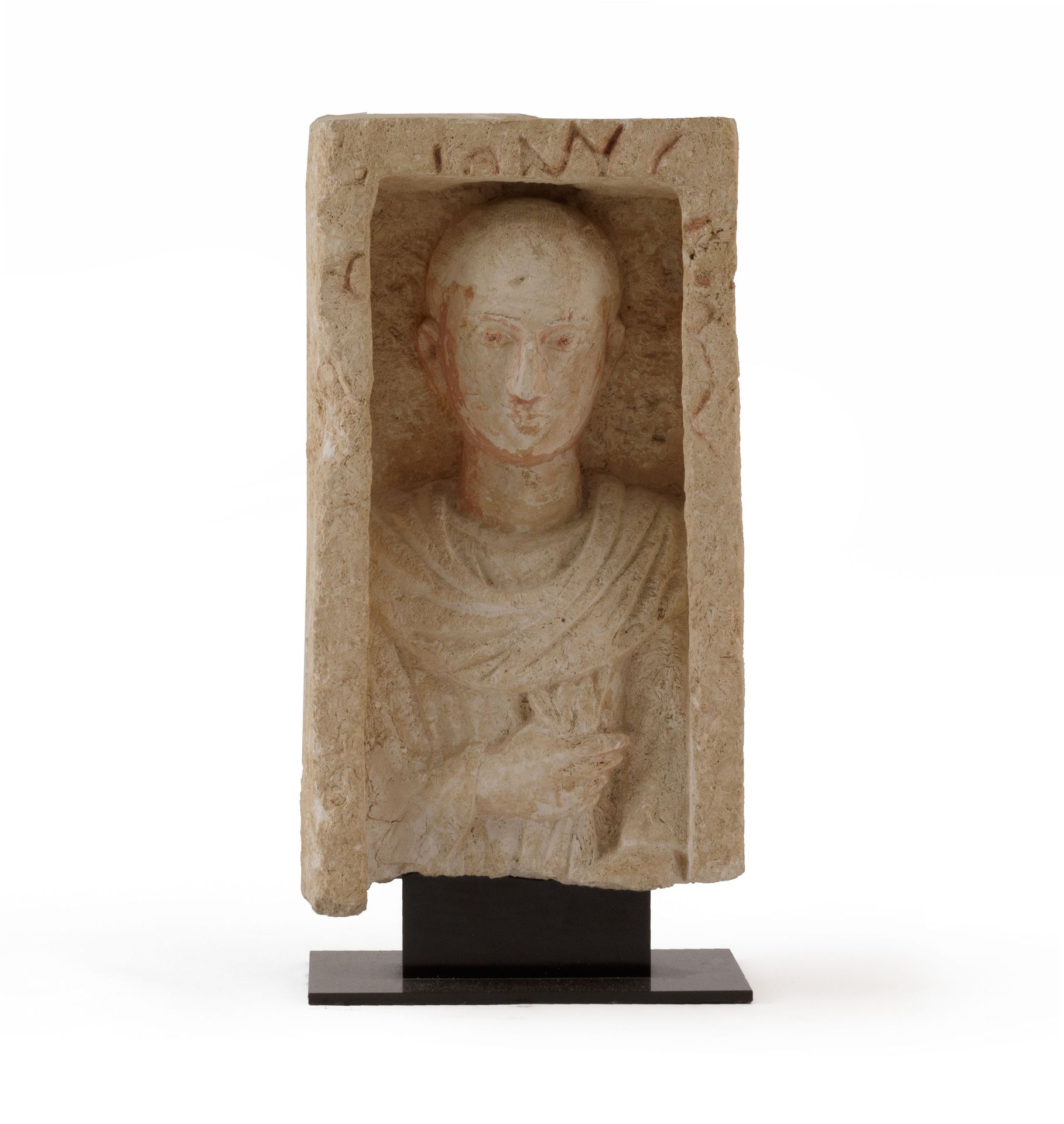Description
Figure dans une niche. Egypte, Oxyrhynchus, l'actuelle el-Behnasa.
Roman-Egyptian tomb figure. Egypt, Oxyrhynchus, (currently el-Behnasa). Limestone. Provenance: Polak Works of Art, Amsterdam, 13.4.2011 During the Greek and Roman rule over Egypt, from 332 and 31 BC respectively, large new settlements evolved where Greeks, Romans, Jews and other foreigners lived together with the indigenous Egyptian population. Several religions were practised side by side, including Judaism and Christianity. The mixture of different cultures resulted in several art styles: a pure Greco-Roman style, a traditional Pharaonic style and a number of mixed styles in which the first two alternately predominated. Roman-Egyptian ‘blending’ styles In the cemeteries of large cosmopolitan cities such as Alexandria and Oxyrhynchus (near present-day el-Behnasa) striking examples of Roman-Egyptian blending styles have been found. The National Museum of Antiquities in Leiden holds one of the largest known collections of grave sculptures from the ancient city of Oxyrhynchus. On the one hand, these sculptures have the characteristics of typical Roman grave sculptures. On the other hand, in terms of technique and theme, they are completely in line with the ancient Egyptian sculptural tradition. The el-Behnasa grave monuments embody a kind of link between Pharaonic and Greco-Roman art, which is closely related to Byzantine art of the early Middle Ages. Figures in niches It is assumed that the el-Behnasa statues come from graves established in the cemetery of Oxyrhynchus between 200 and 400 AD. They are not round statues, but rather tombstones or stelae with images in very high relief. They are made of blocks of rather coarse, locally quarried limestone. The fronts show a niche-shaped chapel with a rounded top, often with two columns in front of it. In these niches we see the almost life-size figures of men, women and children, as if they were standing on the threshold of the kingdom of the dead. Source: Leiden, Dutch National Museum of Antiquities (RMO), https://www.rmo.nl/museumkennis/egypte/de-voorwerpen/romeins-egyptische-graffiguren/. 64.5 x 33 x 20.5 cm Lit.: Klaus Parlasca, 'Grabreliefs Oxyrhynchos,' Enchoria, vol. 8, 1978, p. 117, pl. 36 (E.R. Russmann, Unearthing the Truth: Egypt's Pagan and Coptic Sculpture, Brooklyn, New York, 2009 Description NL Romeins-Egyptische graffiguur. Egypte, Oxyrhynchus, huidige el-Behnasa. Kalksteen. Herkomst: Polak works of art, Amsterdam, 13.4.2011 Tijdens de Griekse en Romeinse overheersing van Egypte, respectievelijk vanaf 332 en 31 v.Chr., ontstonden er grote nieuwe centra waar Grieken, Romeinen, Joden en andere buitenlanders samenwoonden naast de inheemse Egyptische bevolking. Verscheidende godsdiensten werden naast elkaar beleden, waaronder het jodendom en het christendom. De mengelmoes van verschillende culturen bracht verscheidene kunststijlen met zich mee: een zuiver Grieks-Romeinse stijl, een traditioneel faraonische en een aantal mengstijlen waarin de eerste twee afwisselend de boventoon voerden. Romeins-Egyptische mengstijlen Op de begraafplaatsen van grote kosmopolitische steden als Alexandrië en Oxyrhynchus (vlak bij het huidige el-Behnasa) zijn opvallende voorbeelden gevonden van Romeins-Egyptische mengstijlen. In de collectie van het Rijksmuseum van Oudheden in Leiden is de grootste groep grafsculpturen ondergebracht die uit Oxyrhynchus bekend is. Het zijn beelden die aan de ene kant de kenmerken vertonen van typisch Romeinse grafsculpturen. Aan de andere kant passen ze qua techniek en thematiek nog helemaal in de oud-Egyptische beeldhouwtraditie. De ‘Behnasa-graffiguren’ vormen als het ware een schakel tussen de faraonische en Grieks-Romeinse kunst, die weer sterk verwant is aan de Byzantijnse kunst uit de vroege middeleeuwen. Figuren in nissen Aangenomen wordt dat de Behnasa-beelden afkomstig zijn van graven die tussen 200 en 400 na Chr. zijn aangelegd op de begraafplaats van Oxyrhynchus. Het zijn geen beelden in het rond, maar veeleer grafstenen of stèles met afbeeldingen in zeer hoog reliëf. Ze zijn gemaakt uit platen van vrij grove, plaatselijk gewonnen kalksteen. Op de voorkanten is een nisvormige kapel te zien met een ronde bovenkant, vaak met twee zuiltjes ervoor. In deze nissen zien we de bijna levensgrote figuren van mannen, vrouwen en kinderen, alsof ze op de drempel van het dodenrijk staan. Bron: Leiden, Rijkmuseum van Oudheden (RMO), https://www.rmo.nl/museumkennis/egypte/de-voorwerpen/romeins-egyptische-graffiguren/.
250
Figure dans une niche. Egypte, Oxyrhynchus, l'actuelle el-Behnasa.
